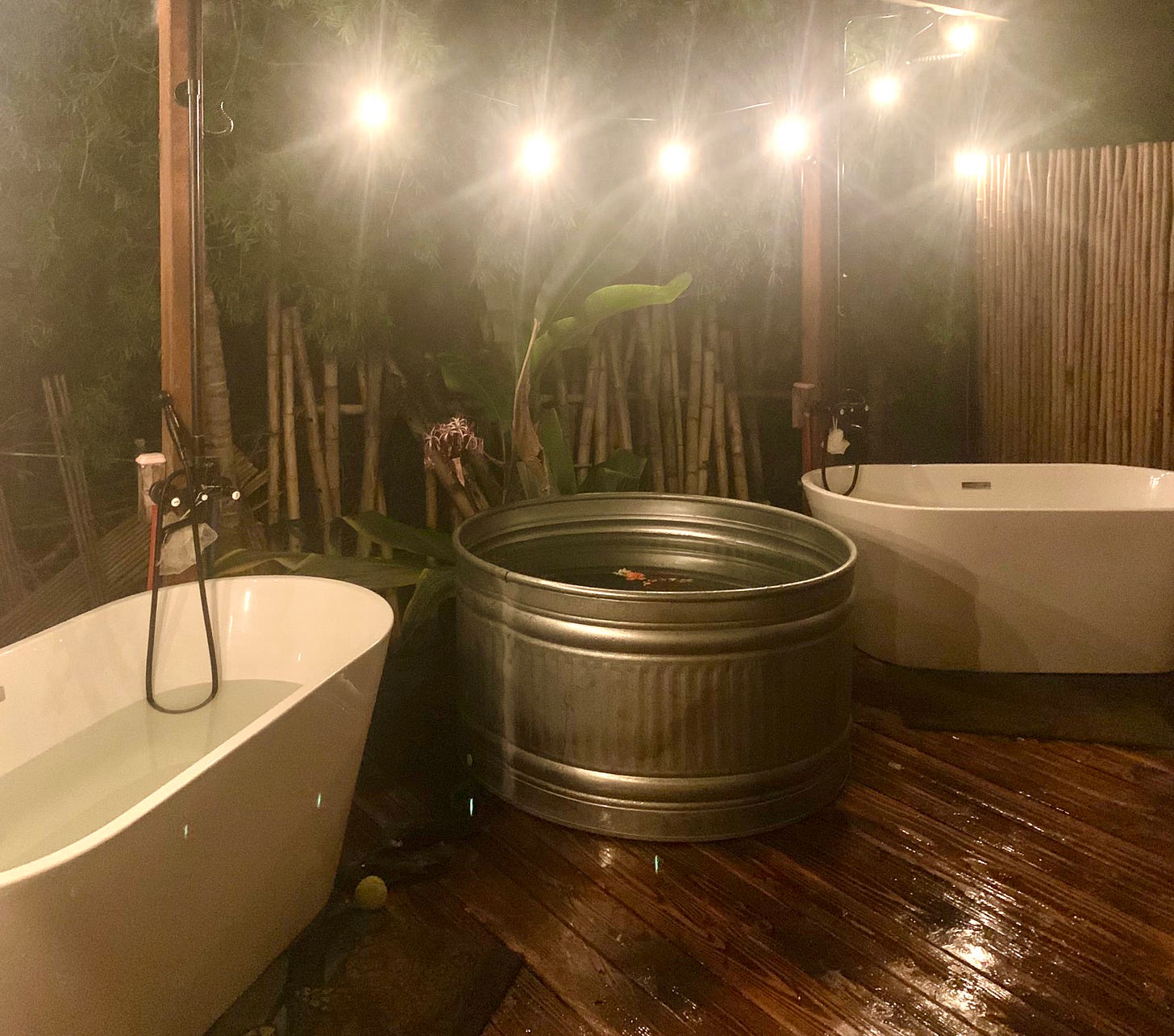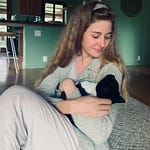I stand on a deck, barefoot in a bathing suit, second in a long line of people who are gathered on a warm Hawaiian night for a cold plunge.
I moved to a place where it’s perennially summer for a reason: I hate the cold.
What am I doing here?
I went to college in Ithaca, which rests in the Snowbelt of upstate New York. Being from Pennsylvania, I thought I knew what cold was — until my first winter there. A short walk across campus from my dorm to a lecture hall in clogs left me with what I assume frostbite feels like. I spent the two-hour astronomy lecture nervously cupping my hands over my heels to bring them back to life. I can still feel that hot sting just thinking about it.
After school, I fled for a more temperate part of the country where I amassed a collection of coats to contend with the San Francisco fog and rain. I wore my coat in the office most days, and for a period of time, worked with a space heater at my feet.
You’d think Iceland wouldn’t be at the top of my travel list. Yet, this time of year five years ago, I took a solo trip there. It was a present to myself for leaving an unhealthy relationship. I had always been intrigued by the other-worldliness I’d seen in photos and heard from friends who’d been. And Sigur Ros, one of my favorite bands was playing at a festival in their hometown of Reykjavik.
I bought a concert ticket and a plane ticket and booked an Airbnb. That was the extent of my planning. Which is how I ended up going to one of the coldest places on earth during the darkest time of the year. I also overestimated the “cityness” of the biggest city in Iceland. With no car and several days left, after I’d exhausted walking up and down the same streets, I booked a bus tour around the Golden Circle, a popular tourist route with stops at a national park, a waterfall, and a geysir.
I layered up stockings and stretch pants under jeans, doubled up on socks, and pulled my puffer jacket over my warmest sweater over a long-sleeved thermal, over an undershirt. I tied it all off with a scarf, wool hat, and mittens and boarded the bus, feeling like my childhood in the snowy Northeast prepared me for this moment.
The second I stepped off the bus, the icy wind cut through my Eskimo coat and all the layers underneath it, freezing my eyelashes and runny nose on contact. I managed to take one photo of the falls before I felt my fingers turn brittle and flashed back to freshman year. I shoved my hands into my coat pockets and bee-lined to the gift shop to buy a too-expensive pair of rabbit fur-lined gloves.
I decided I liked photos of Iceland much better than the experience of being there. I had never been that cold in my life, and I told myself I never wanted to feel that cold again.
That’s why when Kev mentioned that his friend Cason invited us to a cold plunge, my first response was to shoot it down. “What is it, a bunch of naked people in a tub together?”
“I don’t know,” he shrugged, “maybe.”
Kev voluntarily takes 30-second cold showers on occasion, and just hearing him shriek when he gets in gives me goosebumps. But I’ve read about the Wim Hof method and how good cold therapy is supposed to be for the body and mind, allegedly reducing inflammation and improving the quality of sleep, focus, and immune response. So I swallow my resistance and pack a bathing suit, a towel, a bathrobe, and socks.
Before we leave, he mentions there will be a bonfire and dinner afterward and I feel my resistance swell again. “What? It’s like a whole thing? I don’t know if I want to do a whole thing tonight… I wanted some time to unwind…” He suggests we take two cars as a compromise, which feels excessive to me, so I agree to suck it up and be social.
I am not getting out of this one.
When we arrive, two women are sitting at a picnic table overflowing with fruit and two little boys are running around. We unload a grocery bag of starfruit we picked from our yard and introduce ourselves. A few people we know from around town start filtering in and we greet them and start the awkward small talk that happens at the beginning of gatherings with people whose faces you know but names you forget.
In an attempt to take it a level deeper, someone comes up with the icebreaker, “What’s your outlet?” Most people say dance or music or surfing. Someone says bare horseback riding and I think, “These are exactly the type of people who would show up for an ice bath.” I keep my answer to myself.
Cason, the guy whose place it is, comes by to welcome us. He’s running around preparing the bonfire and a big pot of curry and chili for after the plunge. He suggests we take a walk around the property and collect some flowers to add to the tub. We take our time, scanning the perimeter for pops of color like it’s an Easter egg hunt. After about 10 minutes a handful of people are holding small bouquets of yellows, purples, magentas, and oranges.
Cason escorts us to the tub area, which is a deck draped in a string of warm lights, three tubs beneath them. He takes a body-sized bag of ice from the tub on the left and dumps it into the galvanized metal tub in the middle, already filled with cold water. He points to the tub to the right of it and instructs us to shower before we enter the ice bath. Then he puts on some calming music and leaves.
I surprise myself when I’m the first in line.
I float my bouquet on top of the ice water like a delicate little raft amidt icebergs and strip down to my bathingsuit. Kev and I planned to go in together, but he went to get a towel, so I let a woman who’s eager to get in go first. She strips naked and steps into the tub.
“Tell me when it’s 1:11” she says to Constantine, an enthusiastic Russian who volunteered to be the timekeeper.
The woman gets out at two minutes, satisfied to have beaten her goal. Everyone claps. “It’s an accomplishment to go even 30 seconds,” Constantine says. “You did awesome!”
Given my wussiness when it comes to the cold, I wonder if I’ll even make it that long.
I keep in mind the tips people who have done this before gave me: Breathe in through the nose and out through the mouth. Rest your tongue on the bottom of your mouth. When it’s pressed to the roof, you’re tense; if you can relax it, you can relax. Push through the initial physical shock, and you’re home-free.
With a handful of people gathered around, Kev and I pick up one leg in tandem and then the other. We lower into the water and I immediately start hyperventilating. It’s the kind of involuntary gasping that happens when you sob as a little kid, gulping air in fits.
Kev is trying to coach me. I hear, “Breathe through your nose, babe! Through the nose!” But I am in shock; I can’t find my breath let alone direct it where to come in or go out.
Constantine announces that we’ve hit 10 seconds. I close my eyes and focus all my attention on my tongue and my breath. Around the 30-second mark, my internal thrashing stops and everything goes still and silent. I relax deeper down into the water and feel an immense sense of calm.
I am no longer cold. I just am.
I think this must be what dying is like. The body tries to fight it at first, but once it accepts it, euphoria sets in. Science says serotonin levels increase three-fold when a body is near death.
I open my eyes to Constantine’s toe-headed little boy swirling the flowers around my neck, like an angel. I smile and he looks away shyly. “One minute and thirty-five seconds!” Constantine shouts like a coach trying to juice up the runt of the team into average performance.
Kev makes a move to exit when we hit the two-minute mark. “We don’t want to overdo it our first time…” he says.
“No, I want to stay,” I say. He is shivering, but he stays with me.
“OK, now let’s go,” he says again at three minutes. I tell him he can get out if he wants; I feel like I can stay in for hours. Then I check myself.
“Is it possible to stay in too long?” I ask the crowd for reassurance. “No,” someone says. “But if you’re shivering and can’t get warm afterward, you might just need to stand in a hot shower or run around for a while to get your body temp back up.”
We hit 3:35 and Kev motions to get out. I still want to stay, but he’s probably right to play it safe. Plus about a dozen people are now waiting their turn to get in. Whatever the time, it’s the perfect amount for what I needed to get from this experience. I stand up close to 4:00, and step out slowly with one leg and then the other.
The deck feels warm beneath my feet. I am not shivering. I’m warmer than I was while waiting.
I’ve read that in the moments before death, time ceases to exist. When the brain experiences extreme stress, its release of the neurotransmitter GABA is disrupted Then the hippocampus, the part of the brain responsible for memory, dumps a large amount of them into the prefrontal cortex (the part of the brain responsible for cognition). This creates the replay of your whole life in just seconds, the “flashing before the eyes” people who’ve had near-death experiences report.
I suppose that takes some of the mystery out of it… but does it? Living people trying to understand death are like newborn babies trying to understand life.
It’s ineffable.
And when we’re let in on the secret at the end, it’s not a moment too soon: after the breathing stops, in our last few moments, we feel infinite because we finally realize that we are.
Credits
Suite pour l'invisible by Ana Roxanne.












Share this post